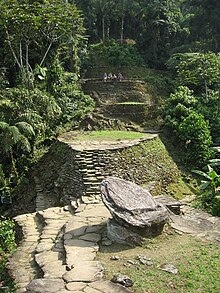Ciudad Perdida
 View of the central area of the city. Wooden structures once stood on the stone platforms. | |
| Alternative name | Teyuna, Buritaca |
|---|---|
| Location | Magdalena Department, Colombia |
| Region | Sierra Nevada de Santa Marta |
| Coordinates | 11°2′16.79″N 73°55′30.69″W / 11.0379972°N 73.9251917°W |
| Type | Settlement |
Ciudad Perdida (Spanish for "Lost City") is the archaeological site of an ancient city in Colombia's Sierra Nevada. It is believed to have been founded about 800 CE, some 650 years earlier than Machu Picchu. This location is also known as Teyuna and Buritaca.
History
Ciudad Perdida was discovered in 1972, when a group of local treasure looters found a series of stone steps rising up the mountainside and followed them to an abandoned city which they named "Green Hell" or "Wide Set". When gold figurines and ceramic urns from this city began to appear in the local black market, archaeologists headed by the director of the Instituto Colombiano de Antropología reached the site in 1976 and completed reconstruction between 1976-1982.
Members of local tribes—the Arhuaco, the Koguis and the Wiwas—have stated that they visited the site regularly before it was widely discovered, but had kept quiet about it. They call the city Teyuna and believe it was the heart of a network of villages inhabited by their forebears, the Tairona. Ciudad Perdida was probably the region's political and manufacturing center on the Buritaca River and may have housed 2,000 to 8,000 people. It was apparently abandoned during the Spanish conquest.
Ciudad Perdida consists of a series of 169 terraces carved into the mountainside, a net of tiled roads and several small circular plazas. The entrance can only be accessed by a climb up some 1,200 stone steps through dense jungle.[1]
The area is now completely safe but was at one time affected by the Colombian armed conflict between the Colombian National Army, right-wing paramilitary groups and left-wing guerrilla groups like National Liberation Army (ELN) and Revolutionary Armed Forces of Colombia (FARC). On September 15, 2003, ELN kidnapped eight foreign tourists visiting Ciudad Perdida, demanding a government investigation into human rights abuses in exchange for their hostages.[2] ELN released the last of the hostages three months later. The United Self-Defense Forces of Colombia (AUC), the paramilitary right-wing groups in that country, continued attacking aborigines and non-aborigines in the zone for a while. For some time the zone has been free of incidents.
In 2005, tourist hikes became operational again and there have been no problems since then. The Colombian army actively patrols the area, which is now deemed to be very safe for visitors and there have not been any more kidnappings. For a six-day return hike to the lost city, the cost is approximately US$300. The hike is about 42 km of walking in total, and requires a good level of fitness. The hike includes a number of river crossings and steep climbs and descents.[3] It is a moderately difficult hike.
Since 2009, non-profit organization Global Heritage Fund (GHF) has been working in Ciudad Perdida to preserve and protect the historic site against climate, vegetation, neglect, looting, and unsustainable tourism. GHF's stated goals include the development and implementation of a regional Management Plan, documentation and conservation of the archaeological features at Ciudad Perdida and the engagement of the local indigenous communities as major stakeholders in the preservation and sustainable development of the site.
Gallery
-
A boulder with carved markings, believed to be a map of the stars.
-
An overview of Ciudad Perdida.
-
This is a section of the stone staircase that leads up from the river valley to Ciudad Perdida.
-
A portrait of a Koguis Tribesman on one of the terraces at Ciudad Perdida.
-
A portrait of a Koguis Tribeswoman and child on one of the terraces at Ciudad Perdida.
-
A portrait of a Koguis shaman at Ciudad Perdida, Colombia.
References
- ^ "Explore the Site". Global Heritage Fund. Archived from the original on 2014-09-08.
{{cite web}}: Unknown parameter|deadurl=ignored (|url-status=suggested) (help) - ^ "Ciudad Perdida Kidnappings". La Ciudad Perdida.
- ^ "Hiking Information".
- Toby Muse - Lost City (Archaeology magazine September/October 2004)
- Soto-Holguin Alvaro "The Lost City of the Tayronas" Im editors, Bogota, 1976.
External links
 Ciudad Perdida travel guide from Wikivoyage
Ciudad Perdida travel guide from Wikivoyage- History and Trekking Guide to La Ciudad Perdida
- La Ciudad Perdida (The Lost City) by Darren Crawford
- A Visual Tour Through Colombia's Ancient Lost City








